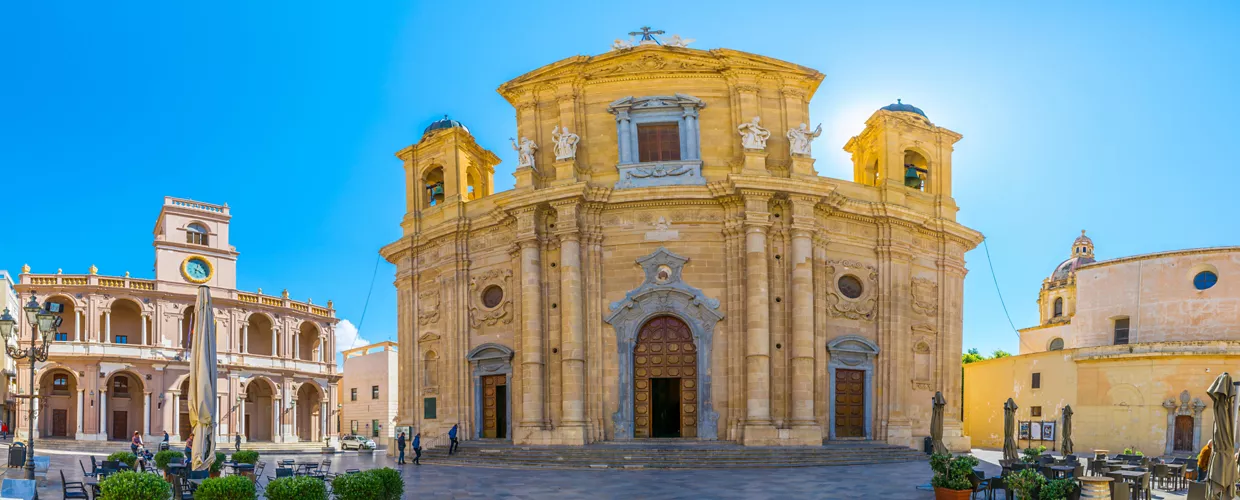
Overview
Marsala, the city of wine and salt
Marsala is a city and it is also a wine. Both are elegant and rich in history.
The city is enclosed within the ramparts of the 16th century, when it experienced its own Renaissance that enriched it with palaces, churches and monasteries.
Wine is the product that has made it world-famous, thanks in part to the intuition of an English merchant who adapted it to British tastes.
In the beautiful historic centre, you can visit the vestiges of its past along with the historic cellars that hold high the prestige of its best product, while on the coast salt is produced in spectacular salt pans.
Between baroque and nature
Those entering from Porta Nuova are greeted by a string of beautiful Renaissance and Baroque palaces, such as the Monastery of San Pietro, which houses the Civic Museum, with an archaeological section and one dedicated to the Risorgimento; Garibaldi and the Thousand landed at Marsala to accomplish the feat of the Unification of Italy.
A little further on, you enter Piazza della Repubblica, Marsala's living room, with the beautiful Palazzo VII Aprile with its Clock Tower and Baroque cathedral, although the façade was not actually completed until 1956, and, next door, the Tapestry Museum where eight Flemish tapestries, a gift from a Spanish king, are on display. A few steps away is the Convento del Carmine, now the Museum of Contemporary Painting with works by various Italian artists including Cassinari, Maccari, Marchegiani, Pomodoro, Sassu, Sironi and temporary exhibitions.
To immerse yourself in Marsala's more ancient past, visit the Baglio Anselmi Archaeological Museum, in the building of a former winery on the seafront: it displays various artefacts narrating the foundation of the city (then called Lilybaeum) by exiles from the Phoenician colony on the island of Mothia.
Don't miss the wreck of a Punic ship that was probably shipwrecked during the battle of the Egadi Islands in the First Punic War, found off the coast of Isola Lunga near Punta Scario, the Roman mosaics and an extraordinary collection of amphorae documenting the trade of antiquity. The museum visit is completed in the archaeological park with the Roman Insula, the site of a large Roman villa from the 3rd century AD with baths, cisterns and the remains of an early Christian necropolis.
Marsala's beating heart is its recently renovated central Fish Market, by day the place where the catch from the Stagnone and the Strait of Sicily pours in, by night the centre of the nightlife where people dine and stay late.
The Marsala wine that pleased the English
Wine has always been produced in Marsala, ever since Phoenician times, but it was towards the end of the 18th century that an English merchant, John Woodhouse, sent some barrels of local wine to England for his customers to taste, but added a dose of aqua-vitae so that the wine would not spoil during navigation.
Thus was born the Marsala we know today, a liqueur wine much appreciated by the English who imported it in quantity, making the fortune of the local producers: Florio, Rallo, Donnafugata, Pellegrino, whose historic cellars are still located in the centre of Marsala.
The Stagnone Reserve and Mozia
The Stagnone Reserve is a lagoon to the north of Marsala, two thousand hectares of shallow and very salty waters within which there are four islands: the Big Island that forms a barrier to the lagoon, the island of Santa Maria, a strip of land, the Schola, because in Roman times it housed a school of rhetoric, where Cicero is said to have taught when he was quaestor of the city of Lilybaetum, and Mothia (Mozia), an island on which stood a Phoenician city from the 8th century BC that ancient sources describe as rich in beautiful palaces, one of the most important trading bases in the ancient Mediterranean. BC that ancient sources describe as rich in beautiful palaces, one of the most important trading bases in the ancient Mediterranean.
Conquered by Dionysius of Syracuse, Mothia was destroyed in 397 B.C. and never rebuilt, so its ruins are 'intact', with no overlays; a true paradise for archaeologists. The survivors in fact founded Lilybaeum, today's Marsala.
The island of Mothia now belongs to the Whitaker Foundation, an English wine producer who bought it and started excavations in the early 20th century, and is open for visits.
The Marsala salt pans and windmills
On the coast to the north of the city, overlooking the Stagnone, are the Salt Pans of the Marsala Ettore and Infersa Lagoon, one of the most spectacular places on the west coast of Sicily, sheets of water that take on different colours depending on the season, against which stand out the outlines of windmills surrounded by mounds of white salt.
A place that is not only very poetic and photogenic, but also of great historical and environmental interest, structured to make visitors experience salt in the round: here one can take walks along the salt pans, visit mills that are still in operation, have tastings, manually harvest salt with the salt miners, and immerse oneself in tanks that are out of production, but still fed by the hydraulic circuit, where one can float in salt solutions with different concentrations and lie on the salt crust.
91025 Marsala TP, Italia